Inbound Marketing Funnel 101: How It Works and How to Use It Right
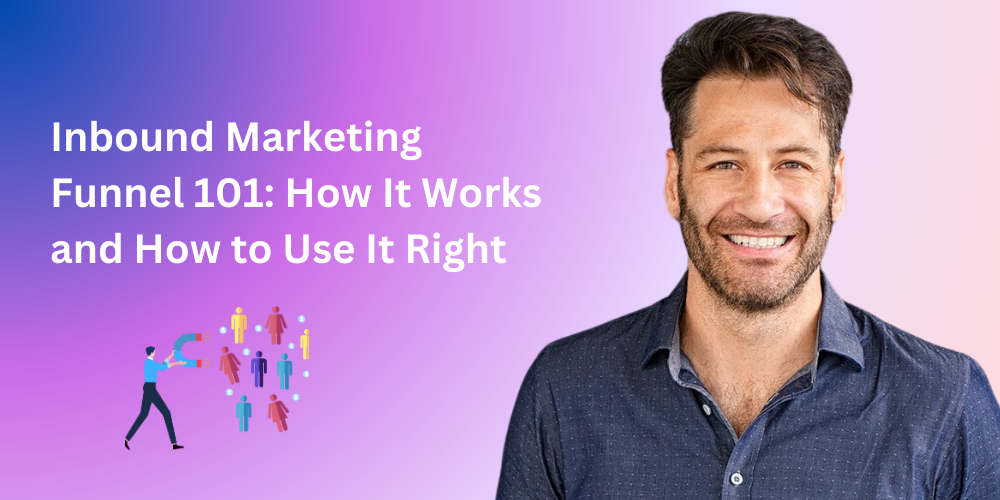
Ever felt like marketing is shouting into a void? Well, say goodbye to cold calls and spammy emails because today we’re diving into the inbound marketing funnel—the secret sauce behind attracting customers who actually WANT to hear from you. The best bit? It’s around 10 times more effective at converting leads than those pesky outbound methods. Sweet deal, right?
So, What Exactly is an Inbound Marketing Funnel?

An inbound marketing funnel is your blueprint for turning strangers into raving fans. It’s all about nurturing relationships through targeted content and genuine engagement. Think of it as a friendly conversation rather than an annoying sales pitch.
Imagine your customer journey like dating:
- TOFU (Top of Funnel): This is like Tinder swiping—they barely know you exist. Your mission? Spark curiosity with swipe-right-worthy content.
- MOFU (Middle of Funnel): Now you're casually dating—they’re interested but still exploring options. Convince them you're the best match.
- BOFU (Bottom of Funnel): Engagement ring shopping—they know you're the one. Now, seal the deal with minimal friction.
How to Build an Inbound Marketing Funnel (That Actually Works!)
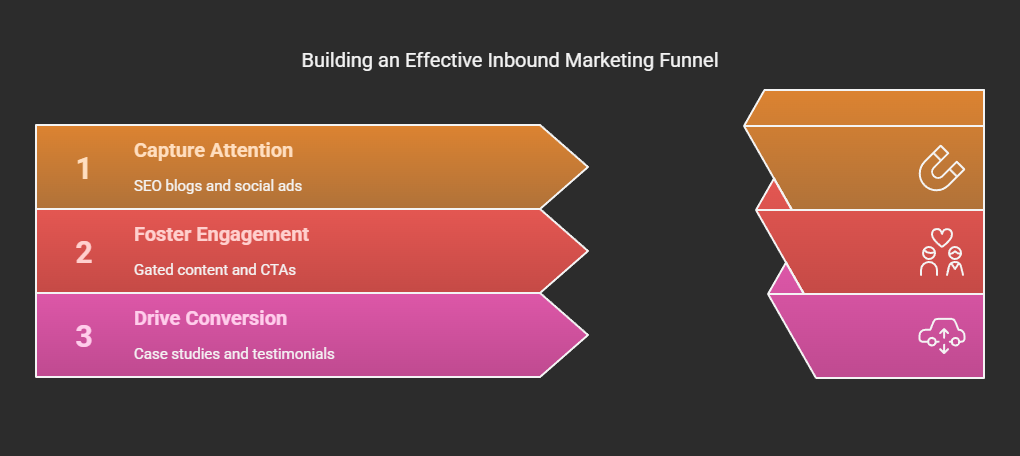
Creating an effective inbound marketing funnel is like hosting a killer party—you've got to welcome guests, keep them entertained, and make sure they never want to leave! Let’s dive into the three key stages that'll make your funnel irresistible (and yes, fun!).
1. TOFU (Top of Funnel) – Making a Memorable Entrance
At the TOFU stage, your audience has no clue who you are—basically strangers at your doorstep. Your goal? Charm them with content they can't resist!
Here’s how to catch their eye:
- SEO-Friendly Blogs: Write in-depth, entertaining articles that Google loves to rank. Think of it like telling the best stories at a party to keep guests intrigued.
- Social Media Ads: Introduce your brand creatively—memes, short videos, or quirky graphics that'll stop their scrolling mid-thumb.
- Google PPC Ads: Appear when they're actively searching for answers, becoming the helpful friend who shows up just in time.
2. MOFU (Middle of Funnel) – Keeping the Conversation Going
Great, your visitors are intrigued, but they're still exploring their options. Now it's time to woo them with content they actually want to exchange their emails for (because emails are the currency of trust!).
Keep it going with:
- Gated Content: Offer irresistible goodies like e-books, white papers, or exclusive webinars behind a simple sign-up form. This is the marketing equivalent of trading candy for friendship.
- Compelling CTAs: Clear, fun, and action-oriented buttons like "Book Your Free Demo " or "Let’s Chat! " encourage users to engage further.
Once you've got their info, nurture them gently—no spammy vibes allowed!
3. BOFU (Bottom of Funnel) – Closing with Confidence (and Charm!)
Here we are—the final stage. Your leads are warmed up and ready to commit. Your job? Make their decision as effortless (and enjoyable) as possible.
Seal the deal with:
- Case Studies: Show off your wins without bragging (too much). Real stories that prove you deliver results.
- Testimonials and Reviews: Let happy clients rave about you—it's always better coming from someone else.
- Automation: Recover abandoned carts, send personalized thank-yous, or automate contract sending. Let technology handle the heavy lifting so you can relax.
- Exclusive Offers: Sweeten the deal with limited-time discounts, bonuses, or a risk-free trial. Everyone loves feeling special.
Four Stages to Nail Every Time 🎯
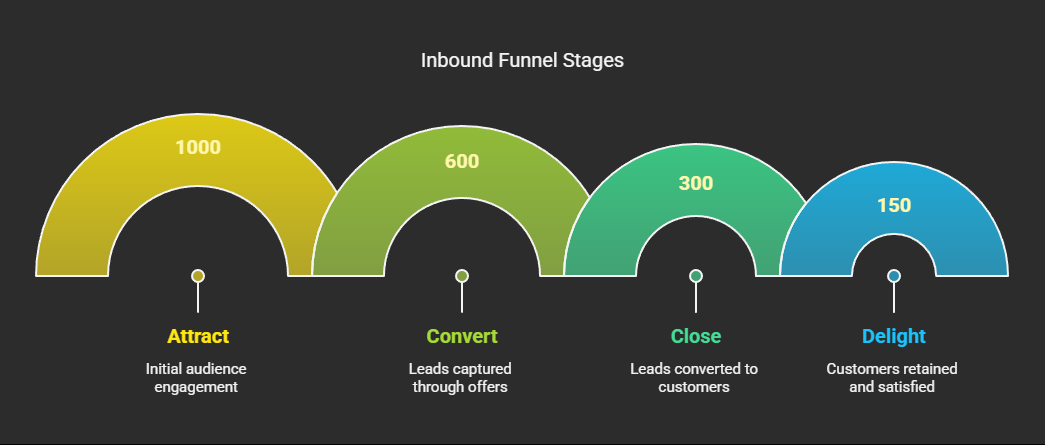
Every inbound funnel follows four essential stages that transform strangers into enthusiastic brand advocates:
- Attract – Charm strangers with helpful, brilliant content.
- Convert – Capture contact info with tempting offers.
- Close – Gently guide leads toward a purchase.
- Delight – Keep customers happy so they spread the word.
Inbound Channels You Can’t Ignore 🌐
These channels are key players in your inbound strategy:
Your Website – Your Digital HQ
Your website is your online home base. Blog frequently, update your content, and consider guest blogging to amplify your credibility. Companies that blog consistently get 67% more leads.
Social Media – Go Where the Party's At 🎉
People practically live on social media. Facebook, LinkedIn, Instagram—pick your poison! Share engaging content, use relevant hashtags, and keep it interactive. Don’t forget to spy—ethically, of course—on your competitors.
Email – Slide Into Their Inbox (Nicely!) 📬
Emails still rock! Personalized emails can boost conversions by up to 50%. Ditch the spam and deliver tailored content your subscribers actually want.
Advertising – Not Just For Big Budgets 💰
Social media and PPC ads can rapidly scale your results. LinkedIn’s hyper-targeted ads work wonders, especially for B2B marketers.
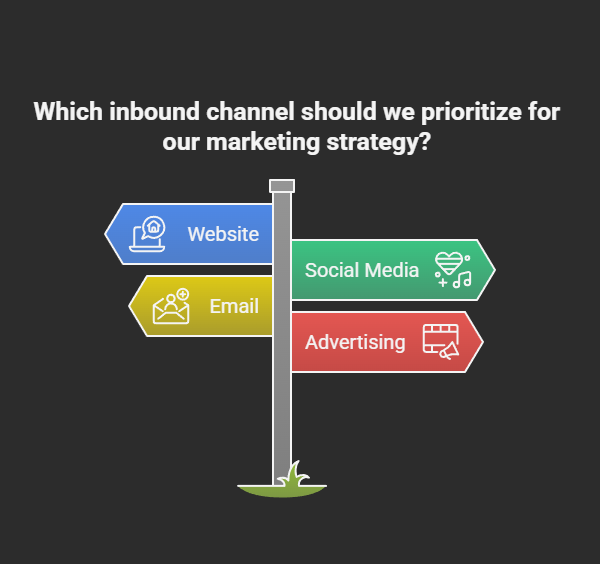
Wait, Isn’t This Just Lead Generation? 🤔
Not exactly. Lead generation is just one part of inbound marketing. Inbound covers the full journey—from attracting prospects with valuable content to turning them into loyal fans.
Types of Inbound Content (That Actually Work!) 📚
Great inbound marketing relies on awesome content. Here’s what really works:
- Blogs: Educational, SEO-rich content.
- Videos: Videos boost lead generation massively—think explainer videos and snappy demos.
- Pillar Pages & Topic Clusters: SEO-boosting, authoritative content.
- Ebooks & Guides: Trade valuable insights for leads.
- Landing Pages: Expertly crafted pages designed for conversions.
- Press Releases: Spread newsworthy stories about your brand.
- Infographics: Easy-to-share, visual-rich information.
- Newsletters: Maintain constant contact with your leads.
- Research Reports: Boost credibility and attract backlinks.
- Podcasts & Webinars: Interactive, conversational, and personal.
- Direct Mail: Old-school but surprisingly effective.
Why You Need Inbound Marketing (Like, Yesterday!) 🚨
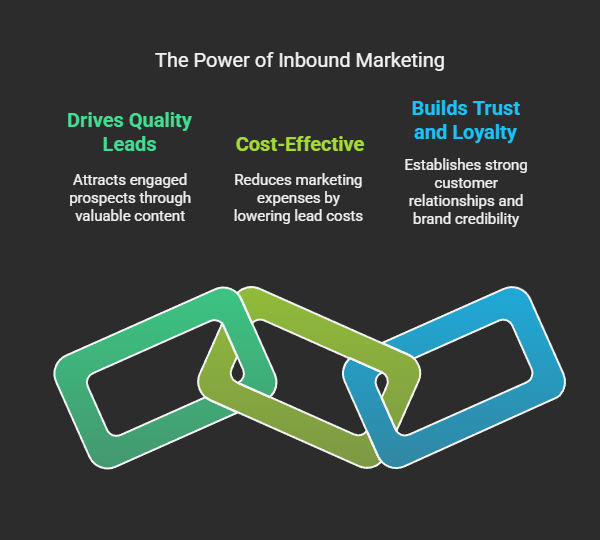
Inbound marketing is a powerful, cost-effective strategy that attracts high-quality leads through valuable content instead of pushy sales tactics. It helps build trust, authority, and lasting customer relationships, making it essential for sustainable business growth. Here's how it does it:
- Drives quality leads—73% of B2B buyers review multiple content pieces before reaching out.
- Cost-effective—Inbound marketing costs 62% less per lead compared to outbound.
- Builds trust, credibility, and lasting brand loyalty.
Lead Types to Know 🧑🤝🧑
Understanding your leads helps you tailor your strategy more effectively, turning interested browsers into committed customers:
- Marketing Qualified Leads (MQLs): These folks are curious but aren't quite ready to buy yet. They’ve engaged with your content and shown interest, making them ideal candidates for further nurturing with targeted information and resources.
- Sales Qualified Leads (SQLs): These leads are ready for direct sales conversations. They’ve indicated serious interest, such as requesting a product demo or pricing details, and they're prepared to make buying decisions.
- Product Qualified Leads (PQLs): Users already familiar with or actively using your product but might be interested in upgrades or additional features. A gentle push with personalized recommendations can turn them into long-term, satisfied customers.
Final Thoughts 💭
Inbound marketing is a rewarding marathon, not a frantic sprint. Feeling overwhelmed? Automation platforms like leadplay.io can simplify your LinkedIn outreach and streamline your entire funnel.
Ready to level up your inbound marketing? Let’s make it happen.